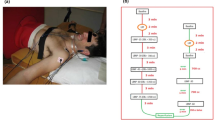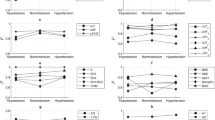Abstract
Objective
The photoplethysmographic (PPG) waveforms are modulated by the respiratory, cardiac and autonomic nervous system. Lower body negative pressure (LBNP) has been used as an experimental tool to simulate loss of central blood volume in humans. The aim of our research is to understanding PPG waveform changes during progressive hypovolemia.
Methods
With IRB approval, 11 volunteers underwent a LBNP protocol at baseline, 30, 75, and 90 mmHg (or until the subject became symptomatic). Subjects were monitored with finger and ear pulse oximeter probes, ECG, and finger arterial blood pressure monitor (FABP). Heart rate variability (HRV) was analyzed to high frequency (HRV-HF) (0.12–0.4 Hz) and low frequency (HRV-LF) (0.04–0.12 Hz). Frequency analysis of PPG waveforms were computed to low (0.04–0.11 Hz) frequency (PPG-LF), intermediate (0.12–0.18 Hz) frequency (PPG-IF), respiratory (0.19–0.3 Hz) frequency (PPG-Resp.) and cardiac (0.75–2.5 Hz) frequency (PPG-Cardiac)during different phases of LBNP protocol
Results
Heart rate increased significantly while systolic, mean and pulse pressure of the FABP declined slowly together with significant reductions in HRV-HF (0.12–0.4 Hz) and HRV-LF (0.04–0.12 Hz) power at LBNP75. There was significant reduction in finger PPG-Cardiac modulation which is consistent with the reduction in the pulse pressure of the FABP. As the LBNP progress there was shift in the amplitude density of the ear PPG-Cardiac to PPG-Resp. Oscillation as an evidence of progressive hypovolemia with reduction in pulse pressure and increase in the respiratory induced variations. At LBNP75, there were significant increased (>140% increase from the baseline) in ear PPG-IF (0.12–0.18 Hz) in the meantime HRV-HF showed significant reduction (>89%) from the baseline. At the symptomatic phase; there was a shift in ear PPG-IF to PPG-Resp. With an increase in the ear PPG-Resp. Modulation to ≥175% from the baseline
Conclusion
The pulse oximeter waveform contains a complex mixture of the effect of cardiac, venous, autonomic, and respiratory systems on the central and peripheral circulation. The occurrence of autonomic modulation needs to be taken into account when studying signals that have their origins from central sites (e.g. ear and forehead).
Similar content being viewed by others
References
Bellamy RF. The causes of death in conventional land warfare: implications for combact causalty care research. Mil Med. 1984;149:55–62.
Mucciarone JJ, Llewellyn CH, Wightman JM. Tactical combat casualty care in the assault on Punta Paitilla airfield. Mil Med. 2006;171:687–690.
Beekley AC, Sebesta JA, Blackbourne LH, et al. Prehospital tourniquet use in Operation Iraqi Freedom: effect on hemorrhage control and outcomes. J trauma. 2008;64:S28–37. discussion 37.
Cannesson M, Attof Y, Rosamel P, et al. Respiratory variations in pulse oximetry plethysmographic waveform amplitude to predict fluid responsiveness in the operating room. Anesthesiology. 2007;106(6):1105–1111.
Michard F. Changes in arterial pressure during mechanical ventilation. Anesthesiology. 2005;103(2):419–428.
Bundgaard-Nielsen M, Holte K, Secher NH, Kehlet H. Monitoring of peri-operative fluid administration by individualized goal-directed therapy. Acta Anaesthesiol Scand. 2007;51(3):331–340.
Abbas SM, Hill AG. Systematic review of the literature for the use of oesophageal Doppler monitor for fluid replacement in major abdominal surgery. Anaesthesia. 2008;63:44–51.
Phillips JP, Kyriacou PA, Jones DP, Shelley KH, Langford RM. Pulse oximetry and photoplethysmographic waveform analysis of the esophagus and bowel. Curr Opin Anaesthesiol. 2008;21(6):779–783.
Convertino VA, Ludwig DA, Cooke WH. Stroke volume and sympathetic responses to lower-body negative pressure reveal new insight into circulatory shock in humans. Auton Neurosci. 2004;111(2):127–134.
Malliani A, Pagani M, Lombardi F, Cerutti S. Cardiovascular neural regulation explored in the frequency domain. Circulation. 1991;84:1482–1492.
Akselrod S, Gordon D, Ubel FA, Shannon DC, Barger AC, Cohen RJ. Power spectrum analysis of heart rate fluctuation: a quantitative probe of beat to beat cardiovascular control. Science. 1981;213:220–222.
Pomeranz M, Macaulay RJB, Caudill MA, et al. Assessment of autonomic function in humans by heart rate spectral analysis. Am J Physiol. 1985;248:H151–53.
Kamath MV, Fallen EL. Power spectral analysis of heart rate variability: a noninvasive signature of cardiac autonomic function. Crit Rev Biomed Eng. 1993;21:245–311.
Rimoldi O, Pierini S, Ferrari A, et al. Analysis of short-term oscillations of R–R and arterial pressure in conscious dogs. Am J Physiol. 1990;258:H967–976.
Montano N, Ruscone TG, Porta A, et al. Power spectrum analysis of heart rate variability to assess the changes in sympathovagal balance during graded orthostatic tilt. Circulation. 1994;90:1826–1831.
Appel ML, Berger RD, Saul JP, Smith JM, Cohen RJ. Beat to beat variability in cardiovascular variables: noise or music? J Am Coll Cardiol. 1989;14:1139–1148.
Middleton PM, Chan GS, O’Lone E, et al. Spectral analysis of finger photoplethysmographic waveform variability in a model of mild to moderate haemorrhage. J Clin Monit Comput. 2008;22(5):343–353.
Mendelson Y. Pulse oximetry: theory and applications for noninvasive monitoring. Clin Chem. 1992;38(9):1601–1607.
Zaniboni M, Formenti P, Umbrello M, Galimberti A, Noto A, Iapichino G. Pulse and systolic pressure variation assessment in partially assisted ventilatory support. J Clin Monit Comput Oct. 2008;22(5):355–359.
Cooke WH, Ryan KL, Convertino VA. Lower body negative pressure as a model to study progression to acute hemorrhagic shock in humans. J Appl Physiol Apr. 2004;96(4):1249–1261.
Silverman D, Stout R. Distinction between atropine-sensitive control of microvascular and cardiac oscillatory activity. Microvasc Res. 2002;63(2):196–208.
Rickards CA, Ryan KL, Cooke WH, Romero SA, Convertino VA. Combat stress or hemorrhage? Evidence for a decision-assist algorithm for remote triage. Aviat Space Environ Med. 2008;79(7):670–676.
Cooke WH, Rickards CA, et al. Autonomic compensation to simulated hemorrhage monitored with heart period variability. Crit Care Med 2008; 36(6): 1892–1899.
Convertino VA, Cooke WH. Relationship between stroke volume and sympathetic nerve activity: new insights about autonomic mechanisms of syncope. J Gravit Physiol. 2002;9:P63–66.
Sundlöf G, Wallin BG. Effect of lower body negative pressure on human muscle nerve sympathetic activity. J Physiol. 1978;278:525–532.
Cooke WH, Convertino VA. Association between vasovagal hypotension and low sympathetic neural activity during presyncope. Clin Auton Res. 2002;12:483–486.
Hayoz D, Noll G, Passino C, Weber R, Wenzel R, Bernardi L. Progressive withdrawal of muscle nerve sympathetic activity preceding vaso-vagal syncope during lower body negative pressure. Clin Sci (Lond). 1996;91:50–51.
Sanders JS, Ferguson DW. Profound sympathoinhibition complicating hypovolemia in humans. Ann Intern Med. 1989;111:439–441.
Van Lieshout JJ, Wieling W, Karemaker JM, Eckberg DL. The vasovagal response. Clin Sci (Lond). 1991;81:575–586.
Gesquiere MJ, Awad AA, Silverman DG, et al. Impact of withdrawal of 450 ml of blood on respiration-induced oscillations of the ear plethysmographic waveform. J Clin Monit Comput Oct. 2007;21(5):277–282.
Lena N, Tomas G, Marcus L, Toste L, Anders J. Respiratory variations in the photoplethysmographic waveform: acute hypovolaemia during spontaneous breathing is not detected. Physiol Meas. 2010;31:953–962.
Partridge BL. Use of pulse oximetry as a noninvasive indicator of intravascular volume status. J Clin Monit. 1987;3(4):263–268.
Shamir M, Eidelman LA, Floman Y, Kaplan L, Pizov R. Pulse oximetry plethysmographic waveform during changes in blood volume. Br J Anaesth. 1999;2(2):178–181.
Andristsos M, Park K. Advantages and limititations of static parameters of fluid loading. Int Anesthesiol Clin. 2010;48(1):1–21.
Marik PE, Cavallazzi R, Vasu T, Hirani A. Dynamic changes in arterial waveform derived variables and fluid responsiveness in mechanically ventilated patients: a systematic review of the literature. Crit Care Med. 2009;37(9):2642–2647.
Author information
Authors and Affiliations
Corresponding author
Additional information
Alian AA, Galante NJ, Stachenfeld NS. Silverman DG, Shelley KH. Impact of central hypovolemia on photoplethysmographic waveform parameters in healthy volunteers part 2: frequency domain analysis
Rights and permissions
About this article
Cite this article
Alian, A.A., Galante, N.J., Stachenfeld, N.S. et al. Impact of central hypovolemia on photoplethysmographic waveform parameters in healthy volunteers part 2: frequency domain analysis. J Clin Monit Comput 25, 387–396 (2011). https://doi.org/10.1007/s10877-011-9317-x
Received:
Accepted:
Published:
Issue Date:
DOI: https://doi.org/10.1007/s10877-011-9317-x




